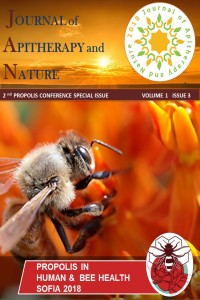Öz
Kaynakça
- 1. Park, YK, Alencar, SM, Scamparini, ARP, Aguiar, CL (2002). Própolis produzida no sul do Brasil, Argentina e Uruguai: Evidências fitoquímicas de sua origem vegetal. Ciência Rural. 2: 997-1003,
- 2. De Figueiredo, SM, Binda, NS, Almeida, BM, Abreu, SRL, Abreu, JAS, Pastore, GM, Sato, HH, Toreti, VC, Tapia, EV, Park YK, Vieira-Filho, SA, Caligiorne, RB (2015). Green Propolis: Thirteen Constituents of Polar Extract and Total Flavonoids Evaluated During Six Years through RP-HPLC.Curr Drug DiscovTechnol.12(4):229-239.
Thirteen Flavonoids from Green Propolis from Minas Gerais, Brazil, Analyzed for Six Years
Öz
Propolis,
a greenish resinous collected by bees, mainly from
plants around their habitat, is
a Greek word resulting from the prefix "pro" (preservation or defense) with "polis" (hive or community or
cluster). There are
13 types of propolis in Brazil, which vary according to the geographical and
botanical origin regions and its different chemical compositions2.
The green propolis
(GrProp) type, derived from plant Baccharis
dracunculifolia, popularly known as rosemary-of-field, gained prominence
for its varied chemical constitution, mainly related to flavonoids. In this study was evaluated the seasonal effect on the chemical
composition of GrProp from Minas Gerais (Brazil) in a period of six years. The GrProp
was collected at February, March, May, July, September and October during six
years (2008-2013). The chemical composition of thirteen flavonoids of GrProp
was evaluated by RP-HPLC and statistical analysis of the results. The
relative amounts of the majority of GrProp flavonoids were similar in most
analyzed samples p-Coumaric acid, chrysin, galangin and kaempferol showed
statistically differences in the analyzes made during the study months and
through the period of analysis. Nevertheless, the results indicated that
GrProp maintained similar and stable characteristics through the six years of
study.
Anahtar Kelimeler
Green Propolis Flavonoids To ConselhoNacional de Pesquisas (CNPq) for financial support (Project: 421544/2016-3)
Kaynakça
- 1. Park, YK, Alencar, SM, Scamparini, ARP, Aguiar, CL (2002). Própolis produzida no sul do Brasil, Argentina e Uruguai: Evidências fitoquímicas de sua origem vegetal. Ciência Rural. 2: 997-1003,
- 2. De Figueiredo, SM, Binda, NS, Almeida, BM, Abreu, SRL, Abreu, JAS, Pastore, GM, Sato, HH, Toreti, VC, Tapia, EV, Park YK, Vieira-Filho, SA, Caligiorne, RB (2015). Green Propolis: Thirteen Constituents of Polar Extract and Total Flavonoids Evaluated During Six Years through RP-HPLC.Curr Drug DiscovTechnol.12(4):229-239.
Ayrıntılar
| Birincil Dil | İngilizce |
|---|---|
| Konular | Mühendislik |
| Bölüm | 2nd Propolis Conference Special Issue |
| Yazarlar | |
| Yayımlanma Tarihi | 8 Aralık 2018 |
| Yayımlandığı Sayı | Yıl 2018 Cilt: 1 Sayı: 3 - 2nd Propolis Conference Special Issue |
Kaynak Göster
ASOS Index

